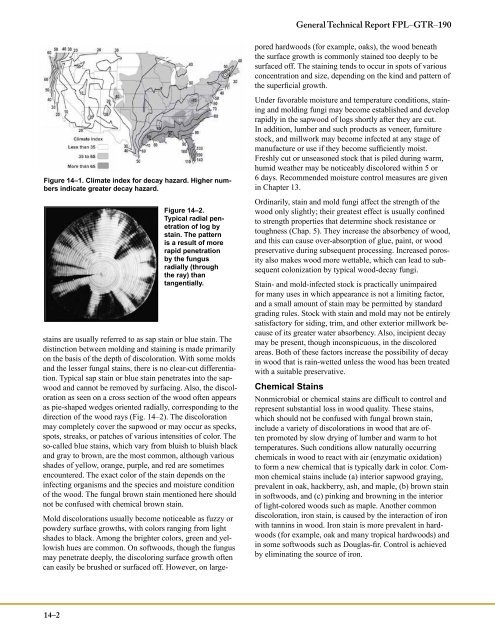Biodeterioration of Wood - Forest Products Laboratory
Biodeterioration of Wood - Forest Products Laboratory
Biodeterioration of Wood - Forest Products Laboratory
Create successful ePaper yourself
Turn your PDF publications into a flip-book with our unique Google optimized e-Paper software.
Figure 14–1. Climate index for decay hazard. Higher numbers<br />
indicate greater decay hazard.<br />
14–2<br />
Figure 14–2.<br />
Typical radial penetration<br />
<strong>of</strong> log by<br />
stain. The pattern<br />
is a result <strong>of</strong> more<br />
rapid penetration<br />
by the fungus<br />
radially (through<br />
the ray) than<br />
tangentially.<br />
stains are usually referred to as sap stain or blue stain. The<br />
distinction between molding and staining is made primarily<br />
on the basis <strong>of</strong> the depth <strong>of</strong> discoloration. With some molds<br />
and the lesser fungal stains, there is no clear-cut differentiation.<br />
Typical sap stain or blue stain penetrates into the sapwood<br />
and cannot be removed by surfacing. Also, the discoloration<br />
as seen on a cross section <strong>of</strong> the wood <strong>of</strong>ten appears<br />
as pie-shaped wedges oriented radially, corresponding to the<br />
direction <strong>of</strong> the wood rays (Fig. 14–2). The discoloration<br />
may completely cover the sapwood or may occur as specks,<br />
spots, streaks, or patches <strong>of</strong> various intensities <strong>of</strong> color. The<br />
so-called blue stains, which vary from bluish to bluish black<br />
and gray to brown, are the most common, although various<br />
shades <strong>of</strong> yellow, orange, purple, and red are sometimes<br />
encountered. The exact color <strong>of</strong> the stain depends on the<br />
infecting organisms and the species and moisture condition<br />
<strong>of</strong> the wood. The fungal brown stain mentioned here should<br />
not be confused with chemical brown stain.<br />
Mold discolorations usually become noticeable as fuzzy or<br />
powdery surface growths, with colors ranging from light<br />
shades to black. Among the brighter colors, green and yellowish<br />
hues are common. On s<strong>of</strong>twoods, though the fungus<br />
may penetrate deeply, the discoloring surface growth <strong>of</strong>ten<br />
can easily be brushed or surfaced <strong>of</strong>f. However, on large-<br />
pored hardwoods (for example, oaks), the wood beneath<br />
the surface growth is commonly stained too deeply to be<br />
surfaced <strong>of</strong>f. The staining tends to occur in spots <strong>of</strong> various<br />
concentration and size, depending on the kind and pattern <strong>of</strong><br />
the superficial growth.<br />
Under favorable moisture and temperature conditions, staining<br />
and molding fungi may become established and develop<br />
rapidly in the sapwood <strong>of</strong> logs shortly after they are cut.<br />
In addition, lumber and such products as veneer, furniture<br />
stock, and millwork may become infected at any stage <strong>of</strong><br />
manufacture or use if they become sufficiently moist.<br />
Freshly cut or unseasoned stock that is piled during warm,<br />
humid weather may be noticeably discolored within 5 or<br />
6 days. Recommended moisture control measures are given<br />
in Chapter 13.<br />
Ordinarily, stain and mold fungi affect the strength <strong>of</strong> the<br />
wood only slightly; their greatest effect is usually confined<br />
to strength properties that determine shock resistance or<br />
toughness (Chap. 5). They increase the absorbency <strong>of</strong> wood,<br />
and this can cause over-absorption <strong>of</strong> glue, paint, or wood<br />
preservative during subsequent processing. Increased porosity<br />
also makes wood more wettable, which can lead to subsequent<br />
colonization by typical wood-decay fungi.<br />
Stain- and mold-infected stock is practically unimpaired<br />
for many uses in which appearance is not a limiting factor,<br />
and a small amount <strong>of</strong> stain may be permitted by standard<br />
grading rules. Stock with stain and mold may not be entirely<br />
satisfactory for siding, trim, and other exterior millwork because<br />
<strong>of</strong> its greater water absorbency. Also, incipient decay<br />
may be present, though inconspicuous, in the discolored<br />
areas. Both <strong>of</strong> these factors increase the possibility <strong>of</strong> decay<br />
in wood that is rain-wetted unless the wood has been treated<br />
with a suitable preservative.<br />
Chemical Stains<br />
General Technical Report FPL–GTR–190<br />
Nonmicrobial or chemical stains are difficult to control and<br />
represent substantial loss in wood quality. These stains,<br />
which should not be confused with fungal brown stain,<br />
include a variety <strong>of</strong> discolorations in wood that are <strong>of</strong>ten<br />
promoted by slow drying <strong>of</strong> lumber and warm to hot<br />
temperatures. Such conditions allow naturally occurring<br />
chemicals in wood to react with air (enzymatic oxidation)<br />
to form a new chemical that is typically dark in color. Common<br />
chemical stains include (a) interior sapwood graying,<br />
prevalent in oak, hackberry, ash, and maple, (b) brown stain<br />
in s<strong>of</strong>twoods, and (c) pinking and browning in the interior<br />
<strong>of</strong> light-colored woods such as maple. Another common<br />
discoloration, iron stain, is caused by the interaction <strong>of</strong> iron<br />
with tannins in wood. Iron stain is more prevalent in hardwoods<br />
(for example, oak and many tropical hardwoods) and<br />
in some s<strong>of</strong>twoods such as Douglas-fir. Control is achieved<br />
by eliminating the source <strong>of</strong> iron.
















